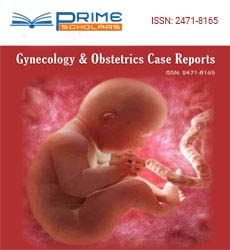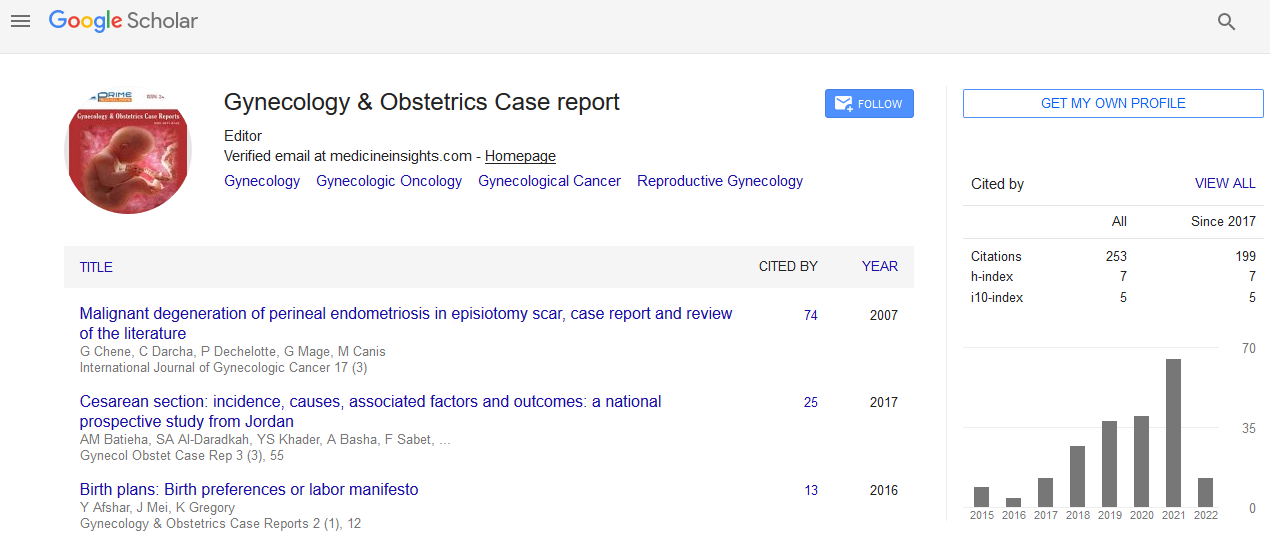Perspective - (2025) Volume 11, Issue 2
Advances in Diagnosis and Management of Polycystic Ovary Syndrome (PCOS)
Hazel Penelope*
Department of Gynecology, University of Ottawa, Ottawa, ON K1H 8M5, Canada
*Correspondence:
Hazel Penelope, Department of Gynecology, University of Ottawa, Ottawa, ON K1H 8M5,
Canada,
Email:
Received: 24-Feb-2025, Manuscript No. ipgocr-25-22704;
Editor assigned: 26-Feb-2025, Pre QC No. ipgocr-25-22704(PQ);
Reviewed: 10-Mar-2025, QC No. ipgocr-25-22704(Q);
Revised: 17-Mar-2025, Manuscript No. ipgocr-25-22704(R);
Published:
24-Mar-2025
INTRODUCTION
Polycystic Ovary Syndrome (PCOS) is one of the most common endocrine disorders affecting women of reproductive age, with a prevalence of around 8-20% globally. The condition is marked by a variety of symptoms, including menstrual irregularities, ovarian cysts and hormonal imbalances that lead to infertility, excessive hair growth, acne and obesity. PCOS has a profound impact on the quality of life and may lead to long-term complications such as type 2 diabetes, cardiovascular disease and endometrial cancer. In recent years, significant advances have been made in understanding the pathophysiology of PCOS, which has translated into better diagnostic approaches and more effective management strategies [1].
The exact cause of PCOS remains unclear, but it is widely accepted that genetic, environmental and lifestyle factors play a role in its development. Insulin resistance is a key feature of PCOS, as it leads to an increase in circulating insulin levels, which in turn stimulates the ovaries to produce excess androgens (male hormones), leading to the symptoms of hirsutism, acne and irregular menstrual cycles. Moreover, elevated insulin levels contribute to the development of metabolic abnormalities, including obesity, dyslipidemia and impaired glucose tolerance, which increase the risk of developing type 2 diabetes and cardiovascular diseases [2]. One of the most critical aspects of managing PCOS is early diagnosis.
Traditional diagnostic criteria, such as the Rotterdam Criteria, require the presence of at least two of the following three features: oligo-ovulation or anovulation (irregular or absent periods), clinical or biochemical signs of hyperandrogenism (e.g., excessive hair growth, acne, or elevated testosterone levels) and polycystic ovaries on ultrasound. However, newer research emphasizes the importance of a comprehensive evaluation that includes a detailed medical history, physical examination and laboratory tests to rule out other potential causes of the symptoms. The inclusion of biomarkers such as Anti-Müllerian Hormone (AMH) levels has proven to be a valuable addition to the diagnostic toolkit, as elevated AMH levels are often found in women with PCOS and correlate with ovarian reserve.
DESCRIPTION
In recent years, advances in imaging techniques, particularly high-resolution ultrasound, have improved the ability to detect polycystic ovaries, which can contain multiple small cysts. These cysts are follicles that have failed to mature and ovulate, a hallmark of PCOS. However, the presence of cysts alone is not diagnostic of PCOS, as many women may have ovarian cysts without the syndrome. Therefore, it is crucial to consider the entire clinical picture when diagnosing PCOS [3]. Once diagnosed, the management of PCOS involves a multidisciplinary approach, tailored to the individualâ??s symptoms, reproductive goals and metabolic health. For women seeking fertility, ovulation induction remains a cornerstone of treatment.
Lifestyle modifications, including weight loss through diet and exercise, are recommended as first-line interventions, as even a modest reduction in weight can improve insulin sensitivity, restore menstrual regularity and enhance the chances of conception. Metformin, a medication commonly used to treat type 2 diabetes, has also been found to improve insulin sensitivity and can be used to restore ovulatory cycles in some women with PCOS. In cases where lifestyle changes and medications are insufficient, ovulation induction agents such as clomiphene citrate and letrozole are used to stimulate ovulation. These medications work by blocking estrogen receptors, which leads to an increase in the secretion of gonadotropins and the stimulation of ovulation. In more complex cases, gonadotropin injections or assisted reproductive technologies like In Vitro Fertilization (IVF) may be employed.
Despite the benefits of ovulation induction, women with PCOS undergoing fertility treatment should be monitored closely for the risk of Ovarian Hyperstimulation Syndrome (OHSS), a condition characterized by an excessive response to ovulation induction drugs [4]. For women who do not wish to conceive or are experiencing symptoms such as hirsutism or acne, hormonal contraception is often the first line of treatment. Combined Oral Contraceptives (COCs) are commonly prescribed to regulate menstrual cycles, reduce androgen production and improve skin conditions. Additionally, anti-androgen medications such as spironolactone can be used to manage symptoms of excess hair growth and acne. It is important to note that while hormonal treatments are effective in managing symptoms, they do not address the underlying metabolic issues associated with PCOS. The metabolic aspects of PCOS, particularly insulin resistance, require ongoing management to reduce the risk of developing type 2 diabetes and cardiovascular disease. In addition to lifestyle changes, medications such as metformin and thiazolidinediones may be prescribed to improve insulin sensitivity. Studies have shown that metformin not only improves metabolic outcomes but also has a beneficial effect on weight and menstrual regularity. However, the long-term benefits and risks of metformin for PCOS patients are still being investigated. Psychological well-being is another crucial aspect of managing PCOS.
Many women with the condition experience depression, anxiety and poor body image due to the visible symptoms such as hirsutism and acne, as well as the challenges of infertility. Psychological support, including counseling and cognitive behavioral therapy, may be beneficial for women struggling with the emotional impact of the condition. Support groups and online communities can also provide a sense of solidarity and empowerment, as PCOS can often feel isolating. In addition to conventional treatments, there is growing interest in complementary and alternative therapies for managing PCOS. Acupuncture, herbal remedies and dietary supplements such as inositol have shown promise in improving insulin sensitivity, ovarian function and fertility outcomes. However, while these treatments may offer some benefit, they should not replace conventional medical interventions and should be used under the guidance of a healthcare provider [5].
CONCLUSION
Advances in the diagnosis and management of Polycystic Ovary Syndrome have greatly improved the quality of care for women with this condition. Early diagnosis, a comprehensive treatment plan that includes lifestyle modifications, medical management and psychological support and ongoing research into the underlying causes of PCOS all contribute to better outcomes. As we continue to learn more about PCOS, personalized treatment strategies that address both the reproductive and metabolic aspects of the condition will become increasingly important in helping women lead healthier, more fulfilling lives.
Acknowledgement
None.
Conflict of Interest
None.
REFERENCES
- Domröse CM, Mignon P, Henning L, Walther K, Michael M, et al. (2016) Development of obstetrical and gynecological journals, 2007 to 2013: A trend analysis. Arch Gynecol Obstet 293(6):383-389.
Google Scholar Cross Ref Indexed at
- Austin OG (1956) Massive thrombophlebitis of the ovarian veins; a case report. Am J Obstet Gynecol 72(2):428-429.
Google Scholar Cross Ref Indexed at
- Aleixandre BR, Simon C, Fauser BC. (2015) Trends in clinical reproductive medicine research: 10 years of growth. Fertil Steril 104(1):131-137.
Google Scholar Cross Ref Indexed at
- Iftikhar PM, Ali F, Faisaluddin M, Khayyat A, De Sa MD, et al. (2019) A bibliometric analysis of the top 30 most-cited articles in gestational diabetes mellitus literature (1946-2019). Cureus 25(2):11-17.
Google Scholar Cross Ref Indexed at
- Gupta A, Kennedy B, Meriwether KV, Francis SL, Cardenas-Trowers O, et al (2020). Citation classics: The 100 most cited articles in Urogynecology. Int Urogynecol J 31(4):249-266.
Google Scholar Cross Ref Indexed at
Citation: Citation: Penelope H. (2025) Advances in Diagnosis and Management of Polycystic Ovary Syndrome (PCOS). Gynecol Obstet
Case Rep. Vol.11 No.2:14.
Copyright: Copyright: © Penelope H. This is an open-access article distributed under the terms of the Creative Commons AttributionLicense, which permits unrestricted use, distribution and reproduction in any medium, provided the original author and source are credited.

